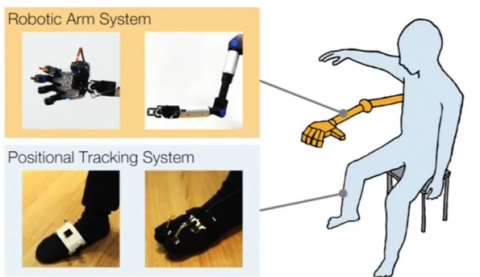
LOS ANGELES, United States (Reuters) — If you’ve ever needed an extra pair of hands, a team of researchers in Tokyo, Japan might have the solution – a set of wearable robotic arms controlled by the motion of the wearer’s feet.
The scientists from the University of Tokyo and Keio University showed off the proof-of-concept prototype for their “MetaLimbs” project at the SIGGRAPH Emerging Technologies showcase in Los Angeles, where it was awarded the “Best in Show” prize.
“We have a set of trackers attached to each foot and it measures the position, orientation as well as the toes’ motion. So when the user moves his limb, his feet, the limbs, the robotic limbs will be moving echoing the same motion. Of course we can finely tune so it doesn’t have to be one-to-one, it can be nonlinear. Plus, like, he can grip objects by moving his toes,” said Yamen Saraiji, a PhD student at Keio University, and part of the research team.
The robotic arm system, which is worn like a backpack, also recreates the sense of touch in the robotic hands using haptic feedback.
“If the limbs touch an object, we have a sensor attached to the palm of the hand as well as to the thumb. So when he grabs an object, he can feel the feedback back on his feet,” Saraiji said.
Saraiji said that among other applications, the system could also help amputees with phantom limb syndrome – a condition experienced by most amputees where “phantom” pain seems to come from a lost limb.
“If we manage to provide the user, the person, a substitute of the missing arm and he can manage to operate it, then probably it can help them to reduce this phantom limb significantly,” Saraiji said.
The team hopes to begin clinical trial soon to see if MetaLimb can give participants the sensation that they’re moving a missing limb.








